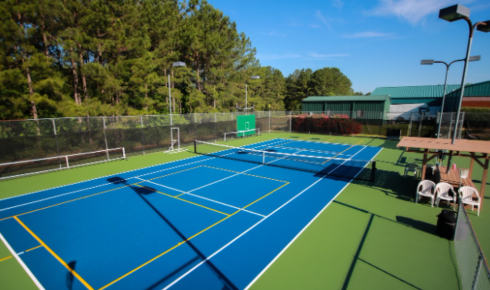Maintaining a tennis court isn’t just about aesthetics — it directly affects play quality, safety, and longevity. Whether you’re managing a school court, a private academy, or a public sport complex, understanding when to resurface a tennis court and why it’s essential can save you from costly repairs later.
In this blog, we’ll walk you through signs that your court needs resurfacing, the ideal time to do it, and why synthetic acrylic sports flooring is one of the most preferred resurfacing materials today.
What is Tennis Court Resurfacing?
Tennis court resurfacing is the process of repairing and renewing the top layers of the court to restore smoothness, traction, color, and performance. It doesn’t mean rebuilding the entire court — rather, it’s a strategic solution that breathes new life into an existing sport court.
Whether the tennis court surface is synthetic, asphalt, or concrete, over time, exposure to sun, rain, and constant play causes it to crack, fade, and become uneven. This not only affects the bounce but increases the risk of player injuries.
When Does a Tennis Court Need Resurfacing?
Most tennis courts require resurfacing every 4 to 8 years, depending on factors like usage, weather exposure, and upkeep. However, time alone isn’t the only indicator. Visible signs often signal the need for attention. Cracks—whether spiderweb-like or deep linear ones—can disrupt gameplay and worsen if left untreated. Fading and discoloration caused by prolonged UV exposure make the court look worn and uneven. Drainage issues, such as standing water after rain, suggest an uneven surface that could lead to further damage. A noticeable loss of traction or grip may cause players to slip or feel discomfort, while inconsistent ball bounce compromises game quality and indicates it’s time to resurface the court.
Tennis Court Dimensions and Surface Area
Before starting the resurfacing process, it’s important to understand the standard tennis court dimensions to accurately estimate material requirements and overall costs. A regulation tennis court measures 78 feet in length and either 27 feet in width for singles matches or 36 feet for doubles, including the doubles alleys. This results in a total playing area of approximately 2,808 square feet. However, when factoring in additional run-off space for safety and proper layout, the total area can range between 2,800 to 7,200 square feet. Knowing these measurements is essential when resurfacing, particularly when applying acrylic floors sport court coatings to ensure a consistent, slip-resistant, and high-performance finish across the entire surface.
Why Resurface Instead of Rebuild?
Tennis court construction is a significant investment, but resurfacing offers a cost-effective alternative that restores both the aesthetics and performance of the court without the need for complete reconstruction. Resurfacing provides multiple benefits, including improved player safety and comfort, enhanced visual appeal with better color retention, and an extended lifespan of the synthetic ground. It also ensures better drainage and consistent ball bounce, while significantly reducing long-term maintenance costs. So, if you’re searching for a “tennis court near me” and come across courts with smooth, vibrant surfaces, there’s a good chance they’ve been resurfaced rather than entirely rebuilt.
Best Surface Options: Synthetic Acrylic Flooring
Today, most modern facilities in India prefer synthetic tennis court flooring made from acrylic materials due to its numerous advantages. Acrylic flooring is highly weather-resistant, standing up well against UV rays, rain, and heat, making it ideal for the Indian climate. Its non-slip surface ensures excellent grip, enhancing player safety and performance. Additionally, it requires minimal maintenance after installation, making it a cost-effective choice in the long run. The flooring also allows for customization with vibrant colors and precise line markings, contributing to a professional appearance. Known for its durability, acrylic courts outlast traditional clay or turf surfaces. Moreover, acrylic layers can be easily applied over older asphalt or concrete bases during resurfacing, offering a smart upgrade that revitalizes the court and enhances the overall playing experience.
Resurfacing Process Step-by-Step
Professional companies follow a systematic and precise process for tennis court resurfacing to ensure durability and performance. The process begins with thorough cleaning and surface preparation, where dirt, moss, debris, and loose particles are completely removed. Next, any existing cracks are addressed using crack fillers or fabric membrane systems for long-lasting sealing. Uneven areas are corrected during the patching and leveling stage with specialized leveling compounds. Once the surface is smooth, an acrylic resurfacer coat is applied as a base layer to prepare it for coloring. This is followed by 2–3 layers of colored acrylic coating, enhancing both the bounce and the visual appeal of the court. Finally, the game lines are painted precisely using high-quality acrylic line paint according to official tennis court dimensions. Each stage is executed with professional attention to detail, ensuring uniform application, adequate drying times, and full compliance with ITF standards.
Why Choose Professional Help?
Partnering with the best sports flooring provider ensures the use of certified synthetic acrylic sports materials, accurate surface levelling, and a high-quality finish. It also guarantees expert knowledge of tennis court measurements and precise game line markings, along with warranty-backed workmanship. Experienced teams bring their expertise to a variety of settings, including schools, clubs, and housing societies. With the rising popularity of synthetic flooring solutions, many volleyball court construction companies in India have now expanded into building tennis and multi-sport surfaces, meeting the growing demand for versatile and durable sports infrastructure.
Conclusion
Whether you’re managing a tennis academy or planning a synthetic tennis court at your club, resurfacing at the right time can make all the difference. From better ball bounce to a safer, visually appealing court — it’s a smart investment that enhances both performance and longevity.
Always measure the tennis court size, understand the area of the tennis court, and work with experienced teams using acrylic flooring to get the best outcome. Resurfacing is more than just a facelift — it’s a functional upgrade that keeps your game at its peak.

